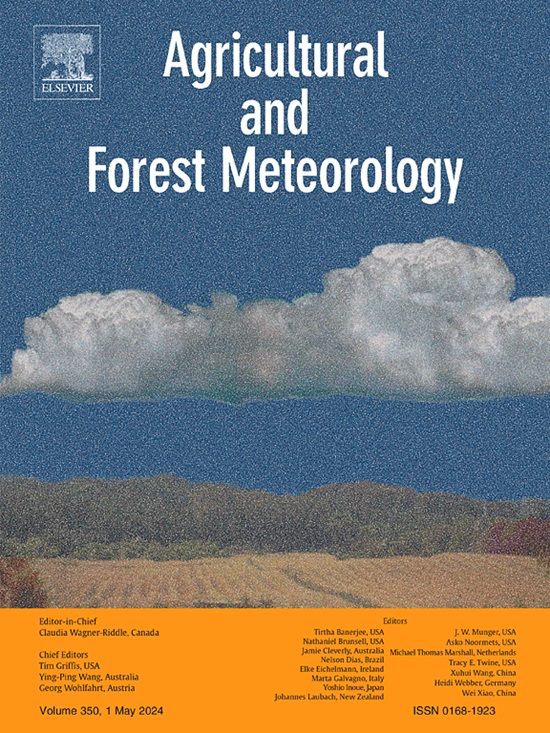Reviving the carbon sink: The influence of moderate wind disturbance in a secondary temperate mixed forest
IF 5.7
1区 农林科学
Q1 AGRONOMY
引用次数: 0
Abstract
Global forests are increasingly exposed to climate-driven perturbations, which may in turn alter their climate mitigation potential. As tropical cyclones expand poleward due to climate warming, wind disturbances in temperate forests have become increasingly frequent. The consequences of moderate wind disturbances remain poorly understood, hindering efforts to quantify their role in the global carbon cycle. Here, we used 16 years of continuous eddy covariance and biometric measurements to investigate the impacts of moderate wind disturbances on the structure and carbon sink dynamics of a temperate forest in Northeast China. Following Typhoon Maysak in 2020, the mortality of large trees (particularly the aging pioneer species) increased ninefold, whereas that of small trees decreased by nearly half. Both stand basal area and leaf area index were reduced between 2019 and 2023, with aging pioneer tree species being more vulnerable than mid-to-late species to wind disturbances. Shifts in species composition altered the environmental sensitivity of forest carbon sink function. Unexpectedly, wind disturbances reversed the declining trends in net ecosystem production and ecosystem carbon use efficiency of this secondary forest. A novel composite structural indicator—the standardized leaf area index (the maximum leaf area supported by per basal area of the stand)—provided robust predictions (R2 > 0.4) of carbon sink dynamics throughout the study period. The selective removal of less efficient pioneer trees accelerated succession and reversed the aging-related decline in forest carbon sink strength and carbon use efficiency. These findings highlight the potential role of moderate wind disturbances in enhancing forest carbon sink function and offer a framework for understanding, assessing, and predicting forest carbon dynamics under increasing disturbance frequencies driven by climate change.
恢复碳汇:中等风扰动对次生温带混交林的影响
全球森林日益受到气候驱动的扰动的影响,这反过来可能改变其减缓气候变化的潜力。由于气候变暖,热带气旋向极地扩展,温带森林的风干扰变得越来越频繁。中度风扰动的后果仍然知之甚少,阻碍了量化它们在全球碳循环中的作用的努力。本文利用16年的连续涡动相关和生物计量测量数据,研究了中等风扰动对东北温带森林结构和碳汇动态的影响。在2020年台风“梅萨克”之后,大树(尤其是老化的先锋树种)的死亡率增加了9倍,而小树的死亡率下降了近一半。2019 - 2023年林分基面积和叶面积指数均有所下降,衰老先锋树种比中后期树种更容易受到风的干扰。物种组成的变化改变了森林碳汇功能的环境敏感性。出乎意料的是,风干扰逆转了该次生林净生态系统产量和生态系统碳利用效率的下降趋势。一种新的复合结构指标——标准化叶面积指数(每林基面积支持的最大叶面积)——提供了稳健的预测(R2 >;0.4)在整个研究期间的碳汇动态。选择性去除效率较低的先锋树加速了演替,逆转了森林碳汇强度和碳利用效率的老化相关下降。这些发现强调了中度风扰动在增强森林碳汇功能中的潜在作用,并为理解、评估和预测气候变化驱动的扰动频率增加下的森林碳动态提供了框架。
本文章由计算机程序翻译,如有差异,请以英文原文为准。
求助全文
约1分钟内获得全文
求助全文
来源期刊
CiteScore
10.30
自引率
9.70%
发文量
415
审稿时长
69 days
期刊介绍:
Agricultural and Forest Meteorology is an international journal for the publication of original articles and reviews on the inter-relationship between meteorology, agriculture, forestry, and natural ecosystems. Emphasis is on basic and applied scientific research relevant to practical problems in the field of plant and soil sciences, ecology and biogeochemistry as affected by weather as well as climate variability and change. Theoretical models should be tested against experimental data. Articles must appeal to an international audience. Special issues devoted to single topics are also published.
Typical topics include canopy micrometeorology (e.g. canopy radiation transfer, turbulence near the ground, evapotranspiration, energy balance, fluxes of trace gases), micrometeorological instrumentation (e.g., sensors for trace gases, flux measurement instruments, radiation measurement techniques), aerobiology (e.g. the dispersion of pollen, spores, insects and pesticides), biometeorology (e.g. the effect of weather and climate on plant distribution, crop yield, water-use efficiency, and plant phenology), forest-fire/weather interactions, and feedbacks from vegetation to weather and the climate system.

 求助内容:
求助内容: 应助结果提醒方式:
应助结果提醒方式:


